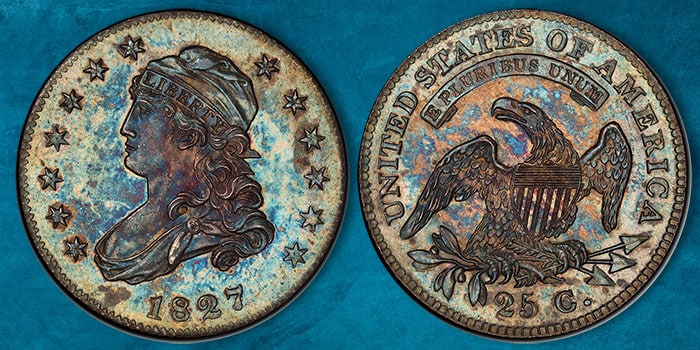
GreatCollections.com offered collectors an opportunity to bid on a beautifully toned, overdate original 1827/3 Capped Bust quarter, graded Proof-65 by PCGS in a gold shield holder. The auction ended on Sunday, March 27.
At the auction’s conclusion, the highest bid on this heavily toned PR 65 1827/3 Capped Bust quarter dollar was $469,146.38 USD after 86 bids.
This specimen is preserved in beautiful Gem condition with only slight wear on a few of the stars and high points of the devices. Accentuating the lustrous deep Proof fields is a striking yet not overwhelming amount of toning. The vivid green and purplish-blue obverse toning nicely complement the orange and blue-hued reverse toning. When viewed as a whole, this piece is simply dripping with eye appeal and with only one example graded higher, at PR 66+, would serve well as the centerpiece of any collection.
Not only is this one of the great rarities of US coinage, but this particular example (the last to be discovered) has an impressive pedigree stretching back to 1867 when it was first discovered in the Joseph Zanoni Collection. In his April 1867 sale of the Zanoni Collection, Edward Cogan, the noted early coin dealer, remarked that this piece was “exceedingly rare” and was worth over $225. Since the Cogan sale, this coin has passed through at least 16 famous 19th- and 20th-century collections and more than a few unknown intermediaries. Some of the most well-known were Major William Wetmore; Virgil Brand; Waldo Newcomer; and United States Circuit Judge Dorothy Nelson.
The present coin was last auctioned by GreatCollections in June 2020. Before that sale, it was sold in January 2019, where it hammered for $444,000, the auction record for this type.
Interestingly, all 1827 Capped Bust quarters are overstrikes, with the “original” type having the “7” repuched over a “3”. The United States Mint struck 4,000 business strikes, the lowest mintage of the entire series. There are, however, only nine known extant Proof examples. All of the 12 initial Proof pieces produced that year were struck from the same pair of dies. This type was subject to intense early numismatic interest starting in 1857, when the New York Dispatch published a letter from an unknown individual named “Outsider” in their September 13 edition, describing the coin type.
Design
The obverse portrait is of a more fulsome Liberty than the previous Draped Bust style, which led to unfortunate albeit unsubstantiated comments that John Reich had modeled Liberty after his “fat mistress”. Liberty is wearing a mobcap (a fashionable woman’s headdress of the period, not a liberty cap as it is sometimes stated) with a band displaying LIBERTY. Long curling hair drapes over the forehead, around the ear, across the shoulders, and down the back. A flowing robe covers the bust and shoulder, fixed with a clasp above the shoulder. Thirteen six-point stars surround the portrait, seven to the left and six to the right, just inside a denticled rim. The date is centered at the bottom.
The reverse displays a left-facing eagle with outstretched though partially folded wings and a Union shield across its breast. The left claw clutches three arrows, the right clutches an olive branch. UNITED STATES OF AMERICA encircles inside the denticled rim around the top two-thirds of the coin, and the denomination of 25 C. is at the bottom, below the eagle. A concentric banner with E PLURIBUS UNUM is located above the eagle’s head, below STATES OF. All coins were minted at Philadelphia and so no mint mark appears on the coins.
The edge is reeded.
* * *
To search through GreatCollection’s archive of over 600,000 certified coins the company has sold over the past eight years, please visit the GreatCollections Auction Archives.




